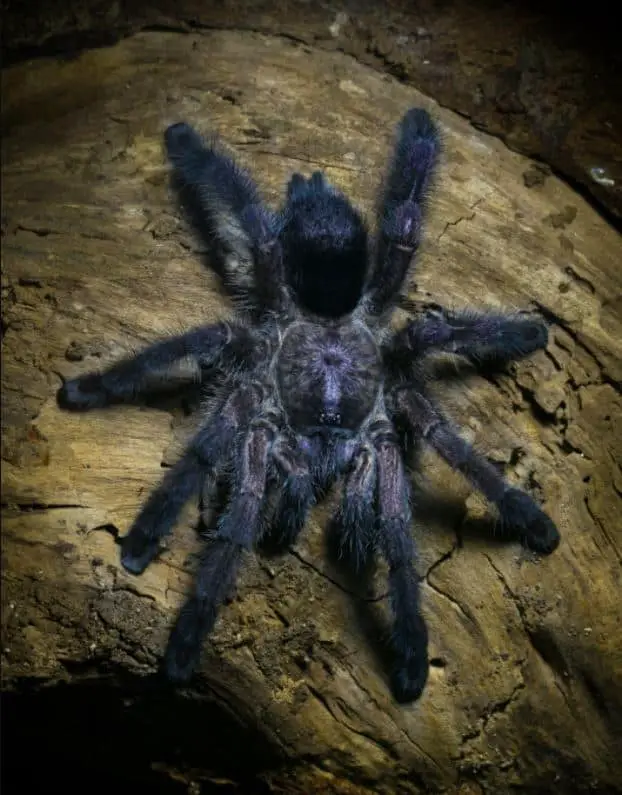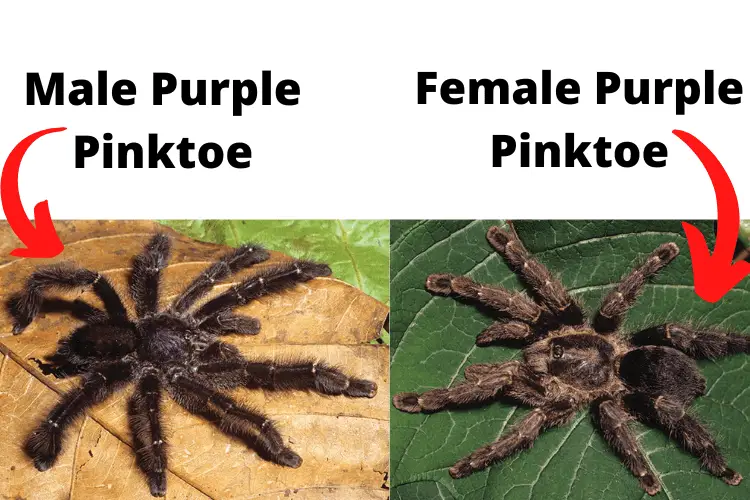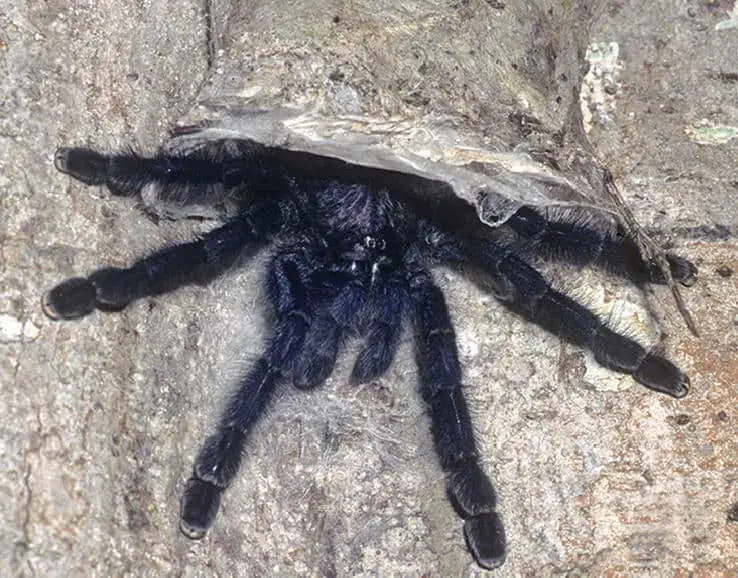The Purple Pinktoe Tarantula (Avicularia purpurea) is a New World Arboreal Tarantula species that is native to Ecuador. It’s well known in the hobby for its gorgeous purple-blue metallic iridescent colors which are truly beautiful to behold.
They’re also quite docile and rarely show defensive behavior, which is why they’re often recommended for newcomers to the hobby.
If the Purple Pinktoe Tarantula has caught your eye, and you’re considering adding one to your collection, here is everything you need to know about them.

Purple Pinktoe Tarantula Care Sheet
| Species Name | Avicularia purpurea |
| Family Name | Theraphosidae |
| Common Names | Purple Pinktoe Tarantula |
| Category | New World |
| Type | Arboreal |
| Native Location | Ecuador, Amazon Rainforest |
| Leg Span | 4 to 5 inches (10 to 13 cm) |
| Growth Speed | Medium – Fast |
| Urticating Hairs | Yes |
| Social | Solitary |
| Diet | Insects: primarily crickets and roaches |
| Temperature | 77 to 82 degrees °F |
| Humidity | 65 to 75% |
| Lifespan | Female: 8 to 12 years / Male: 2 to 3 years |
| Experience required | Beginner |
| Minimum tank size | 12″x12″x12″ |
Purple Pinktoe Tarantula Overview
The Avicularia purpurea, is most well known in the hobby as the Purple Pinktoe Tarantula, but it’s also called the purple tree tarantula, Ecuadorian purple tarantula, or Ecuador purple pinktoe by some people.
In the wild, this spider lives in the Amazon Rainforest, in the part that’s located in Ecuador. There, they live in the trees where they feed on insects.
Like other New World species, they use their urticating hairs to deter predators from eating them.
In captivity, these spiders are generally docile and you really have to push them before they show any kind of defensive behavior.
Appearance & Variants

The Purple Pinktoe’s name is very descriptive of its appearance, but at the same time is a bit misleading.
While the spider is definitely purple in color with a black abdomen, it lacks the pink toes that the name alludes to. Their stunning purple color is iridescent and changes in appearance when viewed from different angles and lighting which is one of their most attractive qualities.
The brightness of their color depends on the specimen. Some have a very bright purple color while others are much darker in appearance. Their coloration also depends on whether or not they’re about to molt. Right after a molt, their colors often are much brighter.
They also have a good amount of hair and are quite fuzzy.
These spiders are dimorphic, with males being quite a bit smaller than females. On the whole, they’re not a particularly large species, topping out at about 4 to 5 inches in leg span.
When it comes to coloration, there’s not much difference between males and females and the easiest way to tell which one you have is by taking a look at their exoskeleton after a molt.
Price
The Purple Pinktoe Tarantula is quite a popular species and they’re not particularly rare, which means that they’re pretty affordable.
Unsexed slings typically go for around $40, while sub-adult males cost $60.
Females typically cost anywhere from $80 to $150. They’re the most expensive of them all because they have a much longer lifespan and grow to a larger size.
Behavior and Temperament

The Purple Pinktoe Tarantula is a very docile species. You really have to press them if you want them to show any defensive behavior. They would much rather run away from any threat than actually fight it off.
If running away does not work and they feel threatened or agitated, they might use their urticating hairs as their first line of defense.
These hairs are quite annoying when they make contact with your skin, and can be dangerous if they make contact with your eyes, nose, or mouth.
It’s easy to get these hairs on your hand, so be careful not to touch your face after interacting with this spider.
This spider is not known for releasing their urticating hairs particularly often, but they do have them, so it’s something to watch out for.
If their urticating hairs are not enough to deter a threat they might take put up a threat posture, but this rarely happens. If they do put up a threat posture, make sure that you back off and leave them alone.
The Purple Pinktoe Tarantula almost never bites.
Of course, they do have fangs and can use them if they have to, but there are very few reports of them ever biting humans.
If they do bite, they have very weak venom, so it should not be much of a problem if you’re not allergic.
Their generally docile temperament in combination with their weak venom means that they’re excellently suited for first-time tarantula owners.
As for behavior in their enclosure, they tend to make a web at the top where they will spend quite a bit of time. However, they do also spend a decent amount of time exploring which means that you’ll get to see their beautiful colors on display.
Caring for a Purple Pinktoe Tarantula
Tank setup
The Purple Pinktoe Tarantula is an arboreal species which means that height is more important than width when it comes to selecting a tank. Since they’re quite small, they do not need a huge tank. 12″x12″x12″ is the minimum they need, but if you give them a bigger enclosure make sure to prioritize vertical space over horizontal space.
It’s also a good idea to choose an enclosure that has doors that open from the front or the sides rather than the top.
These tarantulas have a tendency to create their webs at the top and if you have the door there you will keep breaking their web whenever you feed them or open their enclosure for another reason.
Not to mention the fact that it will make it much more likely for them to escape.
As for a hide, they will need a piece of cork bark or a hollow branch placed vertically in their enclosure. This will simulate the trees that they inhabit in their natural habitat and they will create their hide there.
To spice up their enclosure a little bit you can place some rocks or artificial plants in their terrarium.
Substrate
Substrate is not hugely important for the Purple Pinktoe because they are not borrowers, but they do need it to keep their enclosure moist and to simulate their natural habitat. Provide them with a layer of substrate that is about 2 inches thick.
The substrate should be made up of vermiculite, peat moss, coconut fiber, top soil, or ideally a mixture of any of these components.
Humidity, temperature & ventilation
When housing tarantulas it’s always a good idea to closely simulate their natural environment. The Purple Pinktoe Tarantula lives in a climate where the temperature ranges between 80 and 95 °F, but they are most comfortable in temperatures between 77 and 82 °F.
As for humidity, try to reach a relative humidity of 65 to 75%. You can use a hygrometer to measure the humidity in their enclosure if you want.
If the humidity is too low, you can try to increase it by wettening the substrate or by using a large water bowl, the evaporation of which will increase the moisture in the air.
One thing that is also very important for these spiders is ventilation. If you do not ventilate their enclosure adequately it’s very bad for them. Bacteria will grow very easily in such a humid environment, which can significantly lower your tarantula’s lifespan.
Social
The Purple Pinktoe Tarantula is not a species that can live communally. There have been attempts to house them communally and while some people report that it’s possible if you give them a massive enclosure with a lot of food and space it’s not really worth risking.
Tarantulas do not need company from other members of their species, so it’s best to house them in their own enclosure so that they don’t have to deal with the stress of living near another spider that might have them for lunch.
Diet & Feeding
You should feed your Purple Pinktoe Tarantula a diet that consists of insects.
Purple Pinktoe Tarantula slings should be fed flightless fruit flies, cricket legs, or other insect parts that are pre-killed. Do not try to feed them live food at this stage of their life. Slings are scavengers and are not capable of taking down live prey yet.
As they grow into juveniles, they will become much more powerful and will be able to take down small insects such as pinhead crickets. Make sure that you do not feed them anything larger than their abdomen.
As adults, they have a decent appetite and should be fed a few large crickets, dubia roaches, or mealworms every 10 to 14 days.
Note that your Purple Pinktoe might refuse foods at certain stages of her life. For instance, when they’re about to molt, they will typically stop eating for a few days to make the molting process easier.
Similarly, right after a molt, they should not be fed because their fangs need time to harden before they’re capable of taking down prey.
Lifespan & Health
The Purple Pinktoe Tarantula has a lifespan of 8 to 12 years for females and 2 to 3 years for males.
To keep them healthy, make sure that you keep their enclosure clean, provide them with good ventilation, and feed them captive-bred insects to avoid parasites.
Purple Pinktoe Tarantula Facts
- They can have up to 120 babies after mating
- Females of this species often cannibalize males after they’re done mating
- They eat mostly insects but are also capable of eating small rodents
- The Avicularia purpurea was first described in 19990
Final words: Is the Purple Pinktoe Tarantula Right for you?
The Avicularia purpurea is a beginner-friendly species that is truly beautiful to see. The strong colors on their hairy body make them a fan favorite in the tarantula hobby and they’re a must-have for any serious collector.
They might not be the biggest species in the world, but their gentle temperament and gorgeous colors more than make up for it!
- How Long Do American Eskimo Dogs Live? Important Factors and Care Tips - September 29, 2023
- Do American Bulldogs Need Grooming? Essential Tips and Care Guidelines - September 29, 2023
- Do Bengal Cats Enjoy Playing? Essential Tips for Keeping Them Active - September 29, 2023